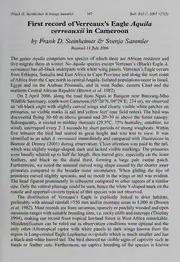
First record of Verreaux's Eagle Aquila verreauxii in Cameroon PDF
Preview First record of Verreaux's Eagle Aquila verreauxii in Cameroon
FrankD. Steinheimer&SvenjaSammler 167 Bull. B.O.C. 2007127(2) First record ofVerreaux's Eagle Aqutla verreauxii in Cameroon & by Frank D. Steinheimer Svenja Sammler Received 11July 2006 The genus Aquila comprises ten species ofwhich three are African residents and five migrate there in winter. No Aquila species except Verreaux's (Black) EagleA. verreauxiihas all-blackunderpartswithwhitewingpanels. Verreaux's Eagle occurs from Ethiopia, Somalia and EastAfrica to Cape Province and along the west coast ofAfricafromtheCapenorthtocentralAngola. IsolatedpopulationsoccurinIsrael, Egypt and on the Arabian Peninsula, and in west Sudan, eastern Chad and the northern CentralAfrican Republic (Brown etal. 1982). On 2 April 2006, along the road from Nguti to Bangem near Banyang-Mbo Wildlife Sanctuary, south-west Cameroon (05°20'N, 09°28'E; 234 m), we observed an 'all-black eagle with slightly curved wings and clearly visible white patches on primaries, no visible marks in tail and yellow feet' (our field notes). The bird was m m discovered flying 50-60 above ground and 20-30 above the forest canopy. Subsequently, it circled in midday thermals (29.3°C, 75% humidity, sunshine, no wind), interrupted every 2-3 seconds by short periods ofstrong wingbeats. Within five minutes the bird had soared to great height and was lost to view. It was identified as an adultA. verreauxii immediately and compared with illustrations in Borrow & Demey (2001) during observafion. Close attenfion was paid to the tail, which was slightly wedge-shaped, dark and lacked visible markings. The primaries were basally whitish up to halfthe length, then barred grey, especially on the inner feathers, and black on the distal third, forming a large pale carpal patch. Furthermore, we noted the unusual curved wing shape caused by the shorter inner primaries compared to the broader outer secondaries. When gliding the tips of primaries curved slightly upwards, and no moult in the wings or tail was evident. The head figured prominently in silhouette compared to other raptors ofa similar size. Onlytheventralplumage couldbe seen, hencethewhiteY-shapedmarkonthe mantle and uppertail-coverts typical ofthis species was not observed. The distribution of Verreaux's Eagle is explicitly linked to drier habitats, mm m preferably with annual rainfall >750 and/or montane areas to 5,000 (Brown etal. 1982). Mostrecords are from savannas, sparselyorpatchilywoodedandopen mountainrangeswithsuitablebreeding sites, i.e. rockycliffsandoutcrops (Thiollay 1994), making our record from tropical lowland forest in WestAfrica remarkable. Misidentification can be ruled out as observation conditions were optimal and the only other Afrotropical raptor with white panels in dark wings known from the region is Long-crested Eagle Lophaetus occipitalis which is much smaller and has ablack-and-white barred tail. The bird showedno visible signs ofcaptivity such as bands or feather cuts. Furthermore, no captive breeding of the species is known FrankD. Steinheimer&SvenjaSammler 168 Bull. B.O.C. 2007127(2) from this region; the nearest zoo holding the species is in SouthAfrica (L. Bosley & B. Huffman in litt. July 2006). Our observation far from any known breeding area suggests a vagrant. Though Verreaux'sEagle isdescribedasnotmigratingorwanderingfar(Brownetal. 1982), already Gargett (1990) andThiollay (1994) stated thatmovementsbetweenpatches of suitable habitat must occur, including over 'significant' distances. Our record might represent part ofa current range extension, as suggested by recent sightings from North and Central Africa: two birds at Tenlaba, Mauritania (Salewski et al. 2005), one in Iherir, Algeria (Salewski et al. 2005), singles at Dinamou and Hombori, Mali (Lamarche 1980), and a breeding record from the Air Mountains, Niger(Newbyetal. 1987). The surroundingsofBanyang-Mboofferhabitats similar to those used by the species elsewhere: inselbergs, rocky hills and montane grasslands. Acknowledgements WegreatlythankRagnarKinzelbach,whoinitiatedandpart-fundedourstudyoflowlandforestbirdsat Banyang-Mbo.WildlifeConservationSocietystaffatNgutiandLimbekindlyfacilitatedandassistedour research. Lydia Bosley, Brent Huffman, Michel Louette and Volker Salewski provided additional information, andRonDemeycommentedonanearlierdraft; wegratefullyacknowledgehis invaluable advice. References: Borrow,N. &Demey,R. 2001.BirdsofwesternAfrica. ChristopherHelm,London. Brown,L. H.,Urban,E. K. &Newman,K. 1982. ThebirdsofAfrica,vol. 1.AcademicPress,London. Gargett,V. 1990. TheBlackEagle.AcornBooks,Randberg. Lamarche,B. 1980. ListecommenteedesoiseauxduMali.Malimbus2: 121-158. Newby,J.,Grettenberger,J.&Watkins,J. 1987.ThebirdsofthenorthernAir,Niger.Malimbus9:4-16. Salewski,V., Schmaljohann, H. & Herremans, M. 2005. Newbirdrecords fromMauritania. Malimbus 27: 19-32. Thiollay,J. M. 1994. FamilyAccipitridae(hawksandeagles). Pp. 52-205 in delHoyo, J.,Elliott,A. 8c Sargatal,J. (eds.)Handbookofthebirdsoftheworld,vol. 2. LynxEdicions,Barcelona. Addresses: Frank D. Steinheimer, Scientific Associate, Bird Group, The Natural History Museum, Akeman Street, Tring, HP23 6AP, UK, e-mail: [email protected]. Svenja Sammler, Institut fiir Biodiversitatsforschung, Allgemeine und Spezielle Zoologie, Universitat Rostock, Universitatsplatz2,D-18055 Rostock,Germany,e-mail: [email protected] ©BritishOrnithologists'Club2007
